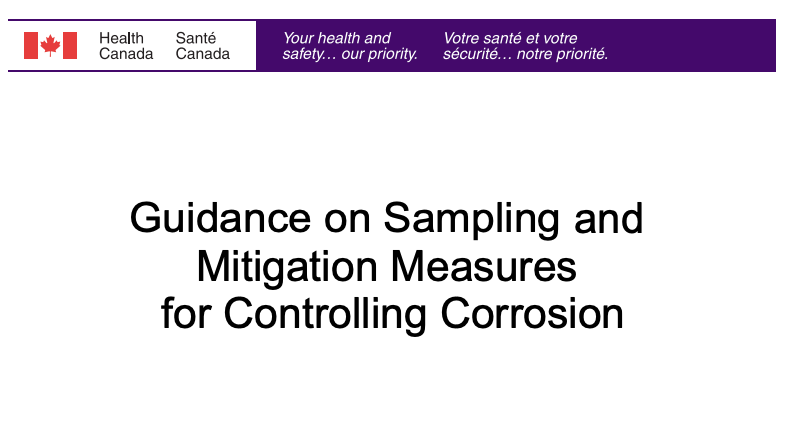
Hi all…Health Canada has posted a request for public comment on the draft document entitled “Guidance on sampling and mitigation measures for controlling corrosion.” They indicate that it “has been developed with the intent to provide regulatory authorities and decision-makers with guidance on sampling and mitigation measures for controlling corrosion in drinking water distribution systems. The document is being made available for a 60-day public consultation period.” Note that the deadline for public comment is Feb 15, 2023.
Comments can be sent via email to Health Canada at water-eau@hc-sc.gc.ca.
Bill
________________________________________________________________________
Draft guidance on sampling and mitigation measures for controlling corrosion
Executive summary
“Corrosion is a common issue in Canadian drinking water supplies. Corrosion is the deterioration of a material, usually a metal, that results from a reaction with its environment. In drinking water distribution systems, materials that could be affected by corrosion and release increased amounts of contaminants (specifically metals such as lead) include metal pipes (e.g., lead service lines) and fittings. There are no direct health effects linked to corrosion in distribution systems, but corrosion may cause the release of contaminants that would be a concern for the health of Canadians. The main contaminant of concern is lead, for which the key health endpoint of concern is the reduction in intelligence quotient (IQ) scores in children. Lead is used as the trigger to initiate corrosion control programs to control or mitigate its release. Corrosion control treatment can effectively minimize lead concentrations at the point of consumption. However, when water is supplied through a lead service line, treatment alone may not be sufficient to reduce lead to concentrations below Health Canada’s maximum allowable concentration (MAC) of 0.005 mg/L (5 µg/L). Therefore, the removal of the full lead service line is likely the most effective and most permanent solution.
In this document, corrosion refers to the internal corrosion of the distribution system and not external corrosion of the infrastructure. Additionally, “corrosion control” refers to the action of controlling or mitigating the release of metals, primarily lead, that results from the corrosion of materials in drinking water distribution systems. Information on components of a corrosion control program is provided. However, detailed operational aspects such as developing a corrosion plan or removal of lead service lines are outside the scope of this document…Microbiologically influenced corrosion is briefly discussed but detailed information is beyond the scope of this document.
Although corrosion itself cannot readily be measured by any single reliable method, the lead levels at a consumer’s tap can be used as an indication of corrosion. Corrosion control programs will vary depending on the responsible authority. They can range from extensive system-wide programs implemented by the water utility to localized programs implemented by a building owner, to ensure a safe and healthy environment for the occupants of residential and non-residential buildings.
This guidance document was prepared in collaboration with the Federal‑Provincial‑Territorial Committee on Drinking Water and assesses all available information on corrosion control in the context of drinking water quality and safety.”
Assessment
“The intent of this document is to provide responsible authorities, such as municipalities and water suppliers, with guidance on assessing corrosion and implementing corrosion control measures for distribution systems in residential settings to minimize exposure to lead. It also provides sampling protocols and corrective measures for multi-dwelling buildings, schools, day care facilities and office buildings for those authorities, such as school boards, building owners or employers, that are responsible for the health and safety of the occupants of such buildings.
This document outlines the steps that should be taken to reduce population exposure to lead, which may also reduce the consumer’s exposure to other corrosion-related contaminants such as copper. Concerns related to other contaminants whose concentrations may be affected by corrosion, such as iron, are also briefly discussed.
This guidance is intended to complement the information provided in the Guideline Technical Document of the Guidelines for Canadian Drinking Water Quality for lead.”





